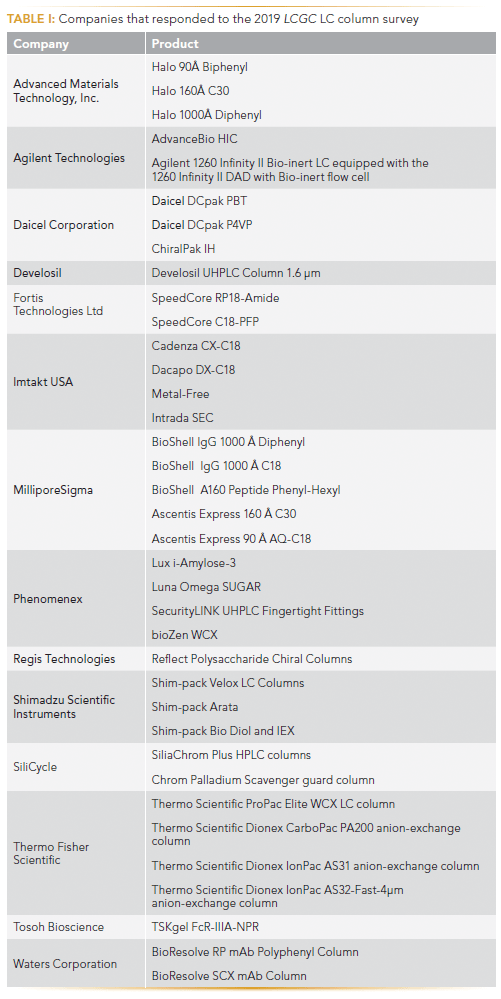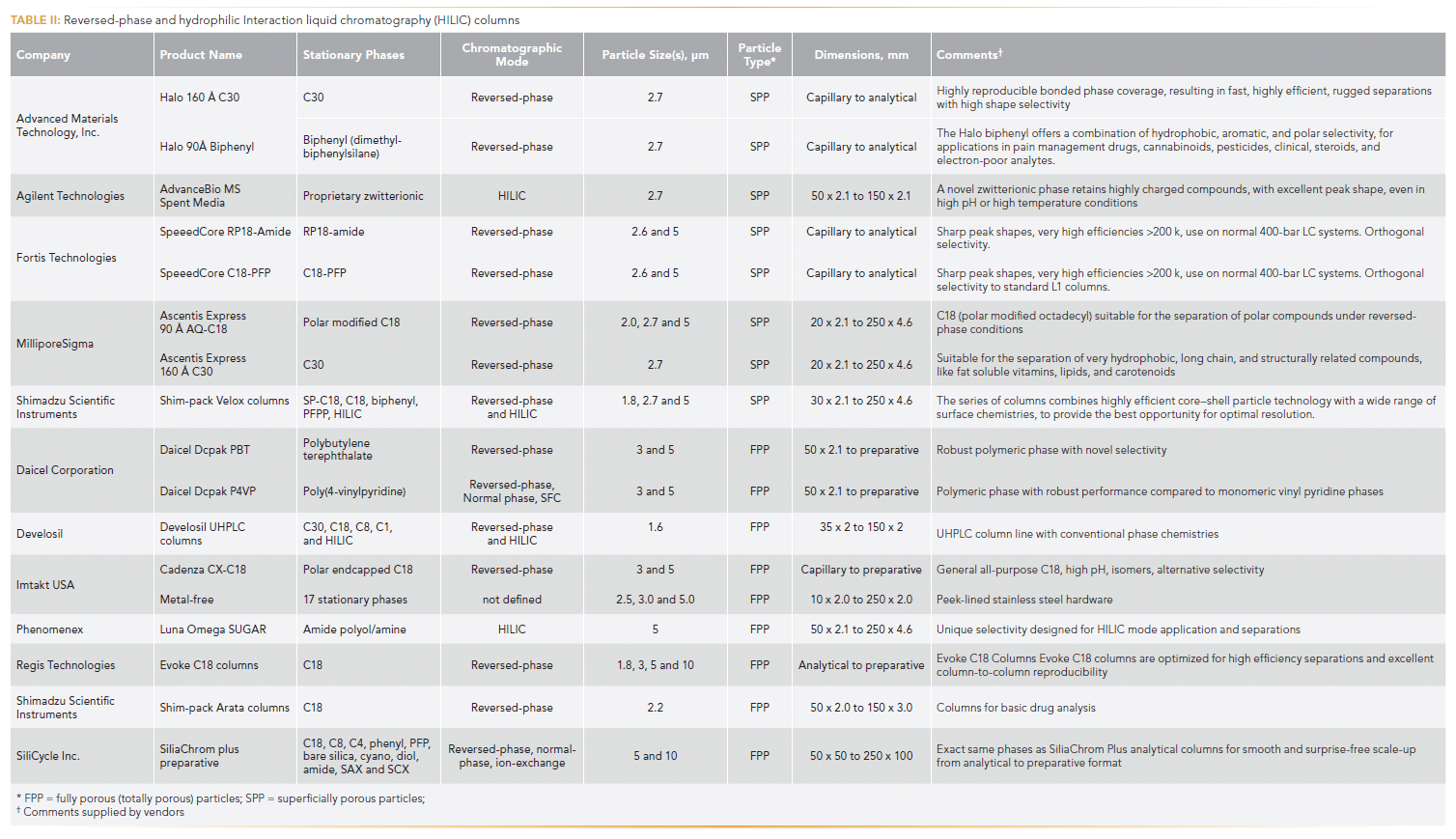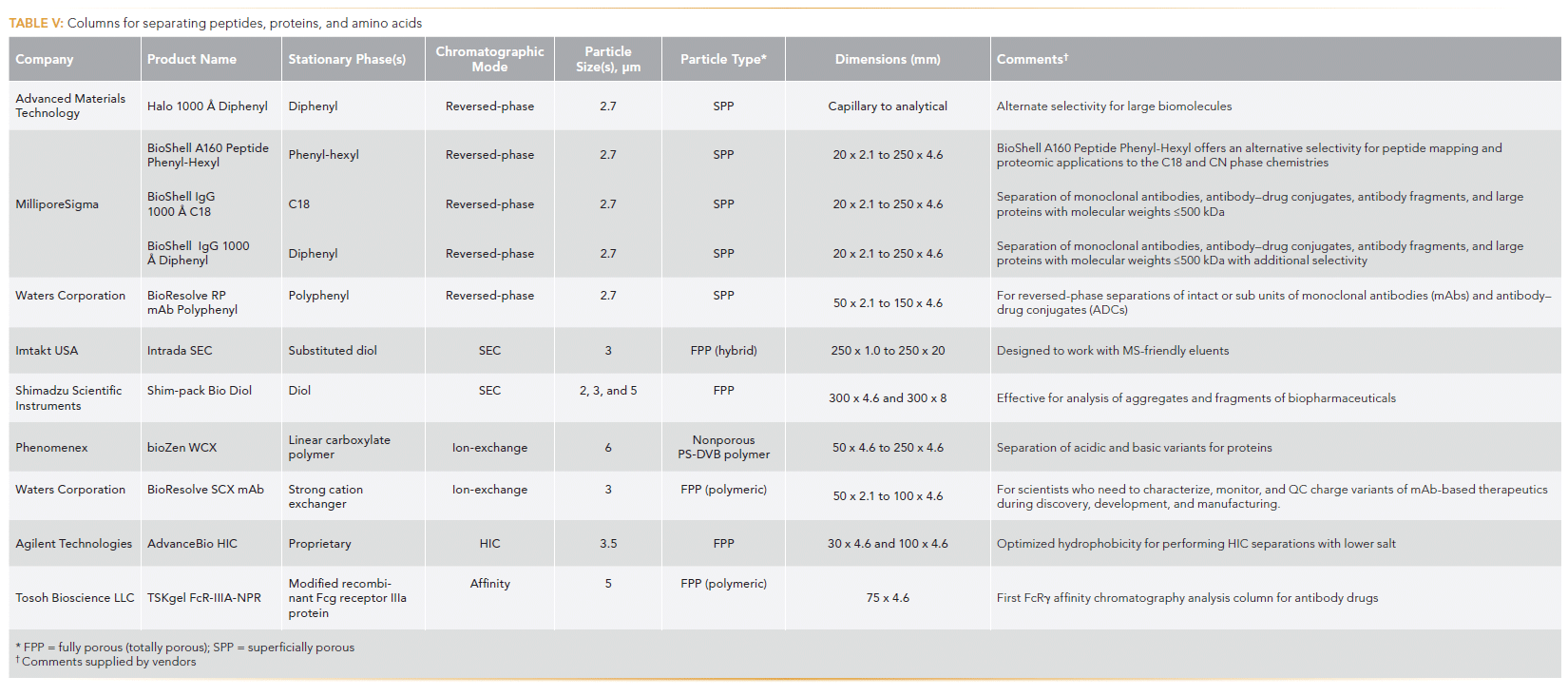New Liquid Chromatography Columns and Accessories for 2019
Our annual review of new liquid chromatography columns and accessories.
This article covers liquid chromatography (LC) columns and accessories commercially released after Pittcon 2018 through this year's conference held in Philadelphia, Pennsylvania. LCGC once again sent out a survey in early 2019, asking vendors to supply information about products launched after Pittcon 2018. Other areas of interest, such as gas chromatography, chromatographic instrumentation, and sample preparation, will be covered elsewhere. Given that information for this article is obtained over the course of many months, it is very possible that some information has been missed. The reader is encouraged to check with specific vendor sites for additional products, as well as more detailed information regarding what is presented in this article.
The vendors that responded to the survey with high performance liquid chromatography (HPLC) and ultrahigh-pressure liquid chromatography (UHPLC) columns are listed in Table I. This year, as in past, the product range is highly varied. The entries can be initially categorized as targeting small molecules or large molecules. Within these categories, the products can be further separated based on the type of particle to which the phases are bonded. Broadly speaking, products from this year were based on superficially porous particles (SPP) or fully porous particles (FPP). Lastly, the products are identified by the specific modes of chromatography (such as reversed-phase or size-exclusion) they employ. Trends noted throughout the article are based on comparisons to previous yearly reports (1–3).

Columns for Small-Molecule Separations
Reversed-Phase and HILIC
The product offerings assigned to the small-molecule category, intended for reversed-phase and hydrophilic-interaction chromatography (HILIC), are listed in Table II. A total of 17 new entries, including multiple column chemistries within a new product line, are shown. The new columns are split nearly evenly between SPP and FPP architectures.

Advanced Materials Technology (AMT) extended its portfolio of SPP phase offerings by launching a C30 chemistry on a 160 Å pore size particle and a biphenyl phase on its 90 Å support. C30 chemistries provide shape selectivity that often results in improved separation of long-chain, structurally related isomers. The company notes that the phase is designed to deliver fast separations, and is 100% aqueous compatible. Biphenyl phases are noted for providing pi-pi interactions, as well as shape selectivity, and often find application in the analysis of pain management drugs, cannabinoids, pesticides, and steroid analyses. AMT claims that the biphenyl phase is also 100% aqueous compatible.
Fortis Technologies and MilliporeSigma also launched new reversed-phase products based on SPP supports. Fortis introduced an RP18-Amide and a C18-PFP, while MilliporeSigma produced a C30 and a polar-modified C18, or AQ-C18, phase. Amide phases often show improved peak shape for basic analytes, and provide alternate selectivity through hydrogen bond interactions (4). Mixed C18 and pentafluorophenyl (PFP) stationary phases provide alternative selectivity to the standard alkyl phase alone. As previously mentioned, C30 columns offer more shape selectivity relative to C8 and C18 phases, and are typically touted as 100% aqueous compatible. MilliporeSigma notes that the C30 phase is suitable for the separation of hydrophobic, structurally related compounds, such as lipids and carotenoids, among others. Polar modification of an alkyl phase can be used to eliminate so-called "dewetting" of the media under highly aqueous conditions. The modification may also provide alternative selectivity when compared to the standard alkyl phase, typically in the form of added retention for polar analytes.
Shimadzu Scientific Instruments introduced a new line of columns based on SPP design. The Shim-pack Velox columns surface chemistries include a couple of C18s, a biphenyl, a pentafluorophenylpropyl (PFPP), and a HILIC phase. The line also consists of 1.8-, 2.7-, and 5-µm particle sizes. According to the company, the series of columns combines highly efficient core–shell particle technology with a wide range of surface chemistries, providing the best opportunity for optimal resolution in a wide variety of applications and challenging separations.
New stationary phases and full product lines continue to be built on FPP supports as well. Daicel Corporation has introduced two interesting polymerically coated silica columns during the past year. The Daicel Dcpak PBT is a polybutyleneterephthalate surface that is noted by the company as generating novel selectivity. The other phase is a poly(4-vinylpyridine) phase that is said to possess robust performance. Daicel informed that these phases can be used in LC and in supercritical fluid chromatography (SFC).
Imtakt USA continued to build its FPP-based product line with the introduction of a polar-endcapped C18, noting that the phase has general purpose, can be run at high pH, and provides alternative selectivity to standard C18 phases. Imtakt also introduced a polyetheretherketone (PEEK)-lined stainless steel hardware line of columns named Metal-Free. The company noted that 17 stationary phases, in multiple dimensions and particle sizes, are now available in this hardware. PEEK-lined stainless steel hardware is commonly used to reduce or eliminate undesired interactions of analytes, such as chelating compounds, with metal surfaces.
Develosil released a new UHPLC column line based on fully porous, 1.6-µm particles. The line contains many of the standard surface chemistries, such as C18, C8, C1, C30, and a HILIC phase. Regis Technologies introduced Evoke C18 columns to the market. According to the company, Evoke C18 columns are packed with high purity silica, and endcapped using a unique gas-phase technology. The process purportedly leads to improved surface coverage and shielding of acidic silanol groups for a highly inert, hydrophobic surface. The company reports excellent separation kinetics and unique selectivity, in comparison to other C18 phases.
Shimadzu Scientific Instruments released an additional product based on FPP supports. The Shim-pack Arata is described as a C18 built on a 2.2-µm particle. Though details are limited, the company claims the phase provides excellent peak shape for basic compounds, while maintaining good peak shape for acids.
Also included in this list is a line of preparative columns from SiliCycle. The SiliaChrom Plus preparative line includes various common stationary phases covering reversed-phase, normal phase, and ion-exchange, on both 5- and 10-µm particles. The company claims smooth scale up from their SilicaChrom analytical columns.
HILIC, which is often used for the retention and separation of polar compounds, has shown steady growth in terms of columns released over the past several years. Only two new HILIC surface chemistries were reported this year, however. Phenomenex introduced the Luna Omega Sugar column, which is described as an amide polyol–amine HILIC phase. The company notes that the novel nitrogen-containing stationary phase greatly increases retention and selectivity for sugars and sugar alcohols under HILIC conditions.
Agilent Technologies also introduced AdvanceBio MS Spent Media columns. The product is a proprietary zwitterionic HILIC phase that retains highly charged compounds with excellent peak shape. The company also notes amino acid separations using this column, without the need for derivatization. There were a few other HILIC phases mentioned within new column lines introduced this year, but it is apparent that development of new HILIC stationary phases has recently slowed down.
Ion-Exchange Chromatography
Products released this year for small molecule ion-exchange chromatography are presented in Table III. Ion-exchange chromatography exploits strong interactions between opposite charges of a surface and an analyte. For the analysis of small ionic compounds, polymeric supports are often modified to carry permanent (strong cation and anion-exchange) or variable (weak cation and anion-exchange) charge, that can be used to interact with and separate analytes with the opposite charge.

The products in this category were all developed by Thermo Fisher Scientific. The Dionex IonPac AS32-Fast-4µm anion-exchange column is reported to be useful for the separation of low polarity anions, polysulfonated aromatics, aromatic dyes, pigments, polythionates, persulfate, and perchlorate. The phase is built on a polymeric ethylvinylbenzene, crosslinked with 55% divinylbenzene with an alkanol quaternary ammonium ion modification. The second column is Dionex CarboPac PA200 anion-exchange column. The company notes that the column provides predictable and high-resolution gradient separation of complex carbohydrates such as oligosaccharides. This phase is also built on a ethylvinylbenzene, crosslinked with 55% divinylbenzene polymer; however, the surface is modified with a quaternary ammonium ion. Lastly, the company introduced the Dionex IonPac AS31 anion-exchange column. This column shares the same polymeric support with the first two with an alkanol quaternary ammonium ion modification. The company reports unique column selectivity that allows faster analysis time while still separating all nine haloacetic acids from matrix ions.
Chiral Chromatography
Table IV provides information on columns introduced this year intended for chiral separations. There are only three entries noted this year, which is far fewer than what was reported in 2018. It is also interesting to note that all of the chiral phases released since Pittcon 2018 were developed on fully porous particles, whereas the previous year products were largely focused on adopting SPP technology.

Daicel Corporation introduced ChiralPak IH, which is an immobilized tris(S)-a-methylbenzylcarbamate chiral stationary phase (CSP). The company claims that the immobilized phase is robust, and exhibits an extended application domain over coated phases. Phenomenex launched the Lux i-Amylose-3 CSP. The column is based on amylose tris(3-chloro-5-methylphenylcarbamate) modification, and is noted as having unique enantioselectivity, for a wide range of chiral molecules.
Regis Technologies released a new line of CSPs called Reflect polysaccharide chiral columns. The columns are available in analytical and preparative dimensions and particle sizes, the latter ranging from 3 to 20 µm. With three surface chemistries, Amylose tris(3,5-dimethylphenylcarbamate), cellulose tris(3,5-dimethylphenylcarbamate), and cellulose tris(3,5-dichlorophenylcarbamate), the line is suitable for a wide range of chiral compounds. The company claims that a unique, proprietary phase coverage provides excellent peak shape and improved resolution versus leading chiral phases.
Columns for Large-Molecule Separations
Reversed-Phase
The complexity of large molecules necessitates the use of multiple modes of separation to fully characterize them. New columns introduced since Pittcon 2018 intended for the separation of large molecules (herein loosely defined as peptides and larger) are provided in Table V. As noted from this list, there have been developments in reversed-phase, size-exclusion chromatography (SEC), ion-exchange, hydrophobic interaction chromatography (HIC), and affinity chromatography over the course of the year. It is interesting to note that all of the columns intended for large molecule, reversed-phase separations have been constructed using SPP technology.

Advanced Materials Technology, MilliporeSigma, and Waters Corporation all introduced columns intended for reversed-phase separation of large molecules based on SPP technology. Of the five different phases introduced, four contain aromatic modifications that provide alternative selectivity to alkyl based phases. The trend of developing alternative selectivity for large molecules is similar to the ongoing trend for reversed-phase small molecule separation tools. AMT and MilliporeSigma launched 1000 Å diphenyl phases. The large pore size is purported to improve peak shapes, especially for very large proteins, and the diphenyl phase is intended to provide alternative selectivity.
MilliporeSigma also released a 1000 Å C18 column for the separation of monoclonal antibodies (mAbs), antibody–drug conjugates (ADCs), antibody fragments and other large proteins. The company also released an addition to their BioShell A160 Peptide line of columns with a phenyl-hexyl modification. The company notes that the phase provides alternative selectivity for peptide mapping as compared to C18 and cyano stationary phases.
Waters Corporation launched a polymeric version of an aromatic phase, called BioResolve RP mAb Polyphenyl, also targeting mAbs and ADCs. The company reports that the phase provides improved chromatography performance, beneficial selectivity, reduced carryover, and friendlier conditions for interfacing with mass spectrometry (MS).
Size Exclusion Chromatography
Size-exclusion chromatography (SEC) is a technique that aims to resolve analytes based on molecular size, and is often used as a complementary technique to other modes of separation for the characterization of large molecules. Columns utilized in SEC are often characterized by strict control of pore size and by inert surface chemistry to minimize analyte–surface interactions.
Matching the number of offerings reported in 2018, two new SEC phases were introduced during the past year. Imtakt USA introduced a 3-µm substituted diol modified silica column, intended for the separation of large biologicals or synthetic polymers. The company notes that the phase is designed to work with MS-friendly eluents.
Shimadzu Scientific Instruments released Shim-pack Bio Diol in 2-, 3- and 5-µm particle sizes. The company offers multiple pore sizes as well, and claims the columns are effective for the analysis of protein aggregates and fragments of biopharmaceuticals.
Ion-Exchange Chromatography
In large-molecule characterization, ion-exchange chromatography is an essential tool to analyze for charged variants, and complements information gained from reversed-phase and SEC analyses. Since Pittcon 2018, two new ion-exchange chromatography columns intended for large-molecule analysis have been launched.
Phenomenex released bioZen WCX, which is described as a linear carboxylate polymer grafted onto a nonporous polystyrene-divinylbenzene (PS-DVB) polymeric bead, that effectively separates acidic and basic protein variants.
Waters Corporation introduced the BioResolve SCX mAb column for the analysis of charge variants of mAb-based therapeutics. This column, also based on a nonporous polymeric support, utilizes a strong cation exchange moiety to enable charge separations.
Hydrophobic Interaction Chromatography
Hydrophobic interaction chromatography (HIC) is another powerful and complementary tool for the characterization of large molecules. HIC makes use of the interactions between hydrophobic regions of the protein, with weakly hydrophobic ligands attached to the stationary phase. Retention is governed by the concentration of salt in the mobile phase. HIC traditionally utilizes high concentrations of nonvolatile buffers, rendering it incompatible with mass spectrometric detection. Significant effort has been made over the past few years to render HIC more MS-compatible (5).
Agilent Technologies launched AdvanceBio HIC, which is a proprietary stationary phase built on a 3.5-µm FPP support. The company claims that the phase was designed to exhibit optimized hydrophobicity for performing HIC separations with lower salt concentrations.
Affinity Chromatography
Affinity chromatography is a separation technique based on highly specific interactions between two partners. Through the immobilization of one partner to a solid surface, the other partner can be effectively "fished" out of a complex mixture with high specificity (1). Affinity chromatography is yet another complementary tool employed to fully characterize large molecules.
Although affinity columns were absent from the 2018 report, affinity has resurfaced in 2019 with one entry from Tosoh Bioscience. Tosoh introduced the TSKgel FcR-IIIA-NPR column, a polymeric-modified recombinant Fcγ receptor IIIa protein, 5-µm, nonporous, affinity-based phase selective for N-glycosylated immunoglobulins. The column is intended for the fast evaluation of antibody-dependent cellular cytotoxicity (ADCC) activity of monoclonal antibodies, cell line screening in early R&D, biosimilar–originator comparison, upstream development–optimization, and monitoring of glycoengineering.
Accessories
Accessories are important products that enable and often facilitate liquid separations. Since Pittcon 2018, two LC accessories have been launched.
Phenomenex recently released the SecurityLink UHPLC finger-tight fitting system. The system is reported by the company to simplify system and column connections, while providing consistent performance through Torque Limiting Technology, which prevents column damage from overtightening. Once the perfect connection has been made through finger tightening, the SecurityLink fitting offers a haptic "click" to confirm that optimum torque has been reached. This ensures a consistent connection each and every time, and prevents over- or under-tightening that may cause column or performance issues.
SiliCycle introduced the SiliaChrom Palladium Scavenger guard column to protect HPLC columns from residual palladium often found in synthesis samples. Palladium scavengers are grafted on silica gel, and packed into guard cartridges to effectively reduce palladium concentrations to single-digit ppm levels, protecting the valuable analytical column.
Conclusions
Columns intended for both small-molecule and large-molecule separations continue to be developed. For small molecules there was an even split of phases built on fully porous particle (FPP) and superficially porous particle (SPP) technologies. Efforts using SPP designs seemed to be focused on alternative reversed-phase selectivity offerings. Companies are, however, continuing to fill out and build new product lines on FPP architecture. There were few new HILIC phases introduced this year as compared to years past, which may indicate a saturation of market.
Large-molecule separations continue to be an area of interest. The need for multiple chromatographic techniques for characterization of these complex systems provides a wide landscape for product invention and introduction. Reversed-phase columns based on SPP technology dominate the offerings. A trend of offering alternative selectivity for large-molecule separation using aromatic stationary phases is noted. This is a similar trend to small-molecule reversed-phase analyses. Products designed for SEC, ion-exchange chromatography, HIC and affinity were also introduced.
Notably absent from the list of products introduced this year is in the area of micro- and nanoscale separation devices. These devices were prevalent in the 2018 report, and noted as a potential trend for the future. It will be interesting to watch for a revival in years to come.
Acknowledgments
Products reviews such as the present work would not be possible without the contributions and cooperation of the manufacturers that have responded to the LCGC survey. Your effort is greatly appreciated.
Although LCGC has made every attempt to include every submission in the series of review articles, it is possible that some have been missed. If there have been omissions or if you want to be sure to be included in the 2020 review series, please contact Laura Bush, the Editorial Director of LCGCNorth America, at LBush@mmhgroup.com.
References
(1) D.S. Bell, LCGC North Amer. 34(4), 242–252 (2016).
(2) D.S. Bell, LCGC North Amer. 36(4), 234–247 (2018).
(3) D.S. Bell, LCGC North Amer. 35(4), 226-239 (2017).
(4) D.S. Bell J. McKenzie, H. Cramer, and C.R. Aurand, LCGC North Amer. 32(9), 704-717 (2014).
(5) D.S. Bell, LCGC North Amer. 35(9), 650-658 (2017).
ABOUT THE AUTHOR
David S. Bell

David S. Bell is a director of Research and Development at Restek. He also serves on the Editorial Advisory Board for LCGC and is the Editor for "Column Watch." Over the past 20 years, he has worked directly in the chromatography industry, focusing his efforts on the design, development, and application of chromatographic stationary phases to advance gas chromatography, liquid chromatography, and related hyphenated techniques. His undergraduate studies in chemistry were completed at the State University of New York at Plattsburgh (SUNY Plattsburgh). He received his PhD in analytical chemistry from The Pennsylvania State University and spent the first decade of his career in the pharmaceutical industry performing analytical method development and validation using various forms of chromatography and electrophoresis. His main objectives have been to create and promote novel separation technologies and to conduct research on molecular interactions that contribute to retention and selectivity in an array of chromatographic processes. His research results have been presented in symposia worldwide, and have resulted in numerous peer-reviewed journal and trade magazine articles. Direct correspondence to: LCGCedit@MMHgroup.com
Perspectives in Hydrophobic Interaction Temperature- Responsive Liquid Chromatography (TRLC)
TRLC can obtain separations similar to those of reversed-phase LC while using only water as the mobile phase.
